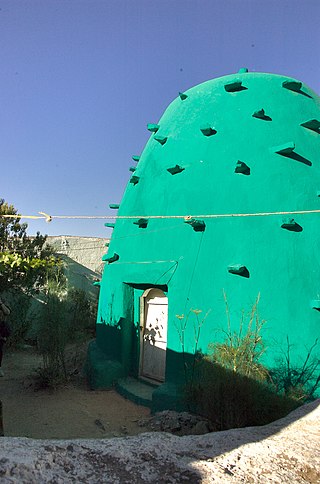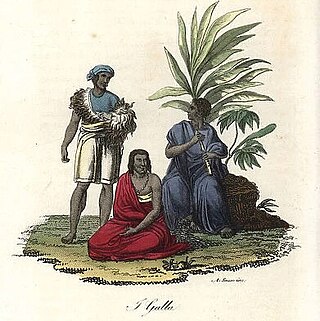
Fedis was a historical region mentioned as far back as the fourteenth century. [1]

Fedis was a historical region mentioned as far back as the fourteenth century. [1]
Historically part of the Adal region, Fedis was first mentioned in the fourteenth century chronicles of Amda Seyon during his invasion of Ifat Sultanate. [2] [3] [4]
In the later half of the seventeenth century it was the domain of the Emirate of Harar. In the early 1800s emir ʽAbd ar-Rahman ibn Muhammad was taken to Fedis as prisoner by the Oromo following his unsuccessful attempt to extract tax from them, this led to his brother emir ʽAbd al-Karim ibn Muhammad seizing the throne in 1825. [5] In 1827 Fedis became a battleground between Oromo factions who supported the aforementioned princes of Harar which devastated three settlements in the region. [6] By the late 1800s, Fedis Oromo state Islam had been firmly established among them following emir Abd ash-Shakur dispatching a Harari Muslim scholar to teach religion and construct a mosque. [7]
Following the severe drought of 1974, the Ethiopian government constructed dams in the area. [8] During the Ogaden War in the 70s, Fedis was a battleground between Ethiopian and Somali forces. [9] It was briefly occupied by the rebel group WSLF with support from Oromo locals. [10]
Fedis is the site of one of the largest market places in the region where goods are sold, the others being Harar and Babile. [11] The narcotic Khat leaf grown in Fedis is most sought after by the elites in the Horn of Africa. [12] A shrine dedicated to saint Aw Barkhadle is also located near this town. [13]

Harar, known historically by the indigenous as Harar-Gey or simply Gey, is a walled city in eastern Ethiopia. It is also known in Arabic as the City of Saints.
Muhammad ibn 'Ali 'Abd ash-Shakur was Emir of Harar before the Egyptian conquest (1856–1875). He is remembered unfavorably by the Harari for favoring the neighboring Oromo people. His son the last emir of Harar, Abdullahi II would succeed him following the Egyptian interval.
Hadiya also known as Adea or Hadia was a medieval Muslim state in the southern part of its realm located south of Shewa and west of Sharkha. The Hadiya Muslim state mainly composed of Cushitic Hadiyya proper, Halaba, Kebena people as well as Semitic Sil'te and other tongues related to Harari language. Hadiya was historically a vassal state of the Adal federation and then became an autonomous province of Abyssinia in the fourteenth century while still remaining a member of the Zeila union. In the 1600s Hadiya regained its independence and was led by a Garad. By 1850, Hadiya is placed north-west of lakes Zway and Langano but still between these areas.
Fedis is a woreda in Oromia Region, Ethiopia. Part of the East Hararghe Zone, Fedis is bordered on the southwest by Garamulleta zone, Meyumuluke woreda, on the west by Girawa, on the northwest by Haro Maya, on the north by the Harari Region, on the east by Babille, and on the southeast by the Erer River which separates it from the Somali Region at south by Midega tola district. The administrative center of this district is Boko.

Nur al-Din or Nur ibn Mujahidibn ‘Ali ibn ‘Abdullah al Dhuhi Suha was an Emir of Harar who ruled over the Adal Sultanate. He was known for marrying his uncle's widow, Bati del Wambara, and also succeeding Imam Ahmad as the leader of the Muslim forces fighting Christian Ethiopia. He is often known as the "King of Adel" in medieval texts.
ʽAbd ar-Rahman ibn Muhammad was the Emir of Harar.

The Harari people are a Semitic-speaking ethnic group which inhabits the Horn of Africa. Members of this ethnic group traditionally reside in the walled city of Harar, simply called Gēy "the City" in Harari, situated in the Harari Region of eastern Ethiopia. They speak the Harari language, a member of the South Ethiopic grouping within the Semitic subfamily of the Afroasiatic languages.
The Harla, also known as Harala, Haralla are an ethnic group that once inhabited Ethiopia, Somalia, and Djibouti. They spoke the now-extinct Harla language, which belonged to either the Cushitic or Semitic branches of the Afroasiatic family.

The Oromo expansions or the Oromo invasions, were a series of expansions in the 16th and 17th centuries by the Oromo. Prior to their great expansion in the 16th century, the Oromo inhabited only the area of what is now modern-day southern Ethiopia and northern Kenya. Over the centuries due to many factors, mostly the wars between the Adal Sultanate and the Ethiopian Empire would further encourage the numerous Oromo tribes to expand towards central and eastern modern Ethiopia.
The Imamate of Aussa, also spelled Imamate of Awsa, was a medieval Sunni Muslim imamate in present-day eastern Ethiopia and north-western Djibouti. Muhammad Gasa established the seat of power to Aussa from Harar in 1577, as the latter was too exposed to Oromo invasions. Internal strife arose from conflicts between the Harla and Arab factions. A Harar faction split from the Imamate in 1647 forming their own independent emirate. The 17th century saw the inclusion of upland Harla and Doba populations playing a pivotal role in the establishment of the Aussa Sultanate. The state was disestablished in 1734 and in 1769, the Mudaito dynasty successfully overthrew the Kabirto of Harla.

The Emirate of Harar was a Muslim kingdom founded in 1647 when the Harari people refused to accept Imām ʿUmardīn Ādan as their ruler and broke away from the Imamate of Aussa to form their own state under `Ali ibn Da`ud.

Hubat, also known as Hobat, or Kubat was a historical Muslim state located in present-day eastern Ethiopia. Historically part of the Adal region alongside Gidaya and Hargaya states on the Harar plateau. Hubat is today within a district known as Adare Qadima which includes Garamuelta and its surroundings in Oromia region. The area is 30 km north west of Harar city at Hubeta, according to historian George Huntingford. Trimingham locates it as the region between Harar and Jaldessa. Archaeologist Timothy Insoll considers Harla town to be Hubat the capital of the now defunct Harla Kingdom.
Aw is an honorific title in the Harari and Somali languages. It commonly designates a father, respected elder or saint in Harari and Somali languages. It is used widely and most commonly in the Somali territories.

Gidaya, also known as Gedaya or Jidaya was a historical Muslim state located around present-day eastern Ethiopia. The state was positioned on the Harar plateau and a district of Adal region alongside Hargaya and Hubat polities. It neighbored other states in the medieval era including Ifat, Mora, Hadiya, Fatagar, Biqulzar, Fedis and Kwelgora.
Adal, known as Awdal or Aw Abdal was a historical Muslim region in the Horn of Africa. Located east of Ifat and the Awash river as far as the coast, and including Harar as well as Zeila. The Zeila state often denoted Adal and other Muslim dominions in medieval texts.
Dakkar, also known as Dakar, or Deker, was a historical Muslim town located in present-day eastern Ethiopia. It served as the first capital of the Adal Sultanate after its founding in the early 15th century by Sabr ad-Din III.

Ifat also known as Yifat, Awfat or Wafat was a historical Muslim region in the Horn of Africa. It was located on the eastern edge of Shewa.

Hargaya was a historical Muslim state in present-day eastern Ethiopia. It was located east of the Awash River on the Harar plateau in Adal alongside Gidaya and Hubat states. It neighbored other polities in the medieval era including Ifat, Fedis, Mora, Biqulzar and Kwelgora.
Muhammad ibn Nasir, reigned 1573–1576, was a sultan of the Sultanate of Adal in the Horn of Africa.
Kwelgora also spelled as Kuelgora was a historical Muslim region located in central Ethiopia, it was bounded by the Ifat and Makhzumi state. The locality was in the vicinity of Aliyu Amba and southward of Ankober.